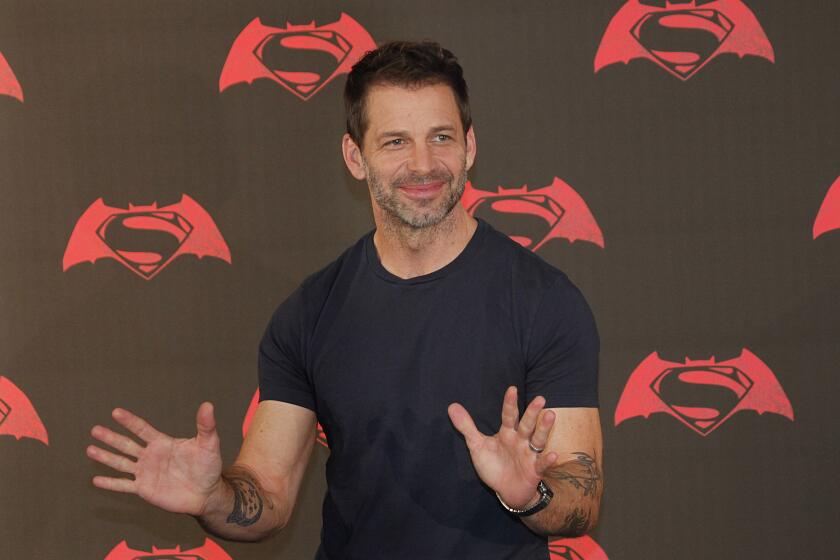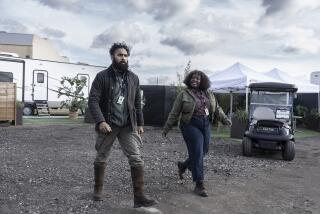Review: ‘Zack Snyder’s Justice League’ has arrived. The wait was long — and so is the movie
Even before Superman rises from a watery grave, eyes aflame and chest bared, the resurrection metaphors pretty much write themselves in “Zack Snyder’s Justice League.” By “Zack Snyder’s Justice League,” of course, I don’t mean the director-disavowed mess that was released under his name four years ago, but rather the director-approved mess that will soon be whooshing, blasting and mostly meandering its way into an HBO Max queue near you.
Clocking in at a jaw-dropping, enervating four hours, this maximalist undertaking is a bid for redemption in an industry that rarely bestows second chances. Or second comings, to judge by the near-messianic fervor that has swirled around the long-anticipated “Snyder cut,” which will surely be greeted in some quarters as the reconstituted “Heaven’s Gate” of superhero epics. O come, all ye DC Comics faithful, the logic goes, and watch as Batman, Superman, Wonder Woman, Aquaman and other franchise stars join forces to save the world (again!) and redeem a filmmaker’s long-stifled vision in the bargain.
This may in fact be something to see, or at least sample. It’s rare, after all, for personal ambition to run afoul of Hollywood’s superhero-industrial complex. Witness the Marvel Cinematic Universe, a smooth-running assembly line in which every last joke, twist and explosion feel pre-chewed for easy digestion. Its DC Comics rivals have felt erratic by comparison: Despite pleasurable outliers like Patty Jenkins’ “Wonder Woman” and James Wan’s irresistibly goofy “Aquaman,” the enterprise has proceeded in clunky fits and starts, in thrall to a house style light on wit and heavy on gloom. As evidenced by his dour “Man of Steel” and the even more leaden “Batman v Superman: Dawn of Justice,” Snyder has been the chief architect of that grimly self-serious aesthetic.
The disappointing critical and commercial reception to “Batman v Superman” was enough to make Warner Bros. think twice about keeping Snyder at the helm of “Justice League.” During production in 2017, the studio turned the film over to Joss Whedon, a practiced crowd-pleaser who had already delivered two successful superhero mash-ups in the “Avengers” series; Snyder, who had been hit hard by personal tragedy, stepped away from the picture.
With his ‘Justice League’ cut due on HBO Max in March, Zack Snyder said he was ‘just kind of done with it’ when he left the movie after his daughter’s suicide.
When the heavily reshot, two-hour “Justice League” was released later that year — with Snyder billed as director and Whedon receiving a writing credit alongside original screenwriter Chris Terrio — Snyder loyalists rejected it and others weren’t much more enthused. In the time that followed, #ReleaseTheSnyderCut emerged as the ultimate fan rallying cry. (Whedon has subsequently faced multiple accusations of workplace harassment, including on the set of “Justice League.”)
In retrospect, it looks like a perfect storm of Hollywood mismanagement — an ill-fated collision of blockbuster auteurism, studio interference and an impassioned, often abusive fan base that has long hailed Snyder as some kind of cinematic visionary. While I’ve been skeptical of that notion at least since the days of “300” and “Watchmen,” I can see its theoretical appeal to moviegoers of a genre persuasion. Snyder is a pulp enthusiast, a meticulous stylist, a skilled orchestrator of violence and a devoted connoisseur of the human midriff. His may be a stunted, self-indulgent vision, but that’s arguably better than no vision at all. It would be satisfying, in a way, to be able to extol the four-hour “Justice League” as a tour de force, consigning Whedon’s version to the pop-cultural trash heap and offering Snyder and his admirers the vindication they’ve long desired.
True, [Whedon’s version] butchered its own convoluted mythology and left crucial material on the cutting-room floor — to which I can only say that by the end of the Snyder cut, I sort of wanted to kiss the cutting-room floor.
But not so fast. (Here I am describing the movie, which unfolds over six leisurely chapters and subjects one sequence after another to a rigorous application of slow-mo.) Having sat through this new “Justice League” in its 242-minute entirety, I can note that the two films represent utterly antithetical approaches to a project that might have benefited from a third, middle-ground option. Forced to choose between the two, the Snyder cut is probably the one I respect more, which doesn’t mean it’s the one I prefer: The two-hour “Justice League” was, for all its baggage, a watchable exercise in damage control, with welcome moments of levity that cut through the murky torpor of Snyder’s storytelling. True, it butchered its convoluted mythology and left crucial material on the cutting-room floor — to which I can only say that by the end of the Snyder cut, I sort of wanted to kiss the cutting-room floor.
But before that end — which includes a very different slam-bang finale and a dreary epilogue teasing upcoming DC agenda items — there are fleeting pleasures and unlikely sources of fascination. Most of the same plot points and personalities are in place, though with immediate differences in tone, duration and rhythm. (And visuals: Every shot, gleamingly photographed by Fabian Wagner, is framed not in widescreen but in the boxier 1.33 aspect ratio.) Moments retained from the theatrical version seem to play out in double time, padded with equally attenuated new material: At the beginning, you get what feels like an eternity of Lois Lane (a still-wasted Amy Adams) staring mournfully into space.
Superman (Henry Cavill) is dead, and the world mourns in unison, this time not to an anguished cover of “Everybody Knows” (though Snyder’s love for Leonard Cohen is evident elsewhere), but rather to the drawn-out sound of Clark Kent’s dying scream. That scream travels the globe, setting off troubling reverberations within the three Mother Boxes — ancient, indestructible repositories of power tucked away in far-flung hiding places.
As various crooning, undulating female voices flood the soundtrack, the camera whooshes through the Themysciran temples of the Amazons, valiant sisters of the righteous Diana Prince/Wonder Woman (Gal Gadot). It travels to Iceland and descends into the underwater enclaves of Atlantis, from which that trident-wielding bodybuilder Arthur Curry/Aquaman (Jason Momoa) is partially descended. It lingers with unusual intensity on a wandering Bruce Wayne (Ben Affleck), bent on forming a powerful team of fighters to fill the void left by Superman’s demise and combat the various supervillains ready to take advantage of it. If that doesn’t quite make Batman the DC Comics equivalent of Nick Fury, it nonetheless intriguingly casts him as more ringmaster than main attraction.
David Boreanaz, Adam Busch, Tom Lenk and Danny Strong address Whedon’s alleged misconduct on social media.
I should confess an unfashionable fondness — an Afflecktion, if you will — for this latest and most self-effacing of Batmen. Affleck doesn’t have Christian Bale’s hauteur, but he’s good at playing golden boys gone to seed (“Gone Girl,” “Hollywoodland”) and it’s amusing to watch this world-weary Bruce Wayne cede the spotlight to his more innately gifted comrades. And those comrades prove worthy of the attention. Gadot is as magnetic a screen presence as she was in the stand-alone “Wonder Woman” movies. Momoa’s ocean-washed mane and lewd eyebrows are among the recent treasures of blockbuster cinema. The younger generation is ably represented by Ezra Miller as Barry Allen/the Flash, who relishes his role as the team’s lightning-limbed goofball, and also by Ray Fisher as Victor Stone/Cyborg, whose brooding metalloid stare bespeaks an unusually rough backstory.
That backstory is unpacked at greater length here, to no complaint from me. It’s nice to peer deeper into Cyborg’s silicon soul and also to spend a little more time with the Flash — and given his gift for slowing the clock, a little goes a long way. One witty jaw-dropper of a sequence finds Barry rescuing a beautiful stranger (Kiersey Clemons) from a car crash: A split-second crawls by and a potential tragedy is reverse-engineered into a meet-cute. (Or maybe a meat-cute, given the crucial role played by a flying hot dog.) You actually want to see what’s in store for Barry and his damsel in vehicular distress (more will be revealed in the upcoming, long-delayed “The Flash”), and also what might come of those occasional, tentative sparks between Bruce and Diana. But even a four-hour “Justice League” has little time for romance.
What it does have time for often feels less than vital: earnest exposition, wall-rattling fisticuffs and comic asides that prove dopier, but also sweeter, than those glib Whedon one-liners. (Spoiler alert: I liked the scene of Jeremy Irons’ Alfred teaching Diana how to brew a cup of tea.) Regrettably, the movie also has far too much time for Steppenwolf (voiced by Ciarán Hinds), the latest intergalactic destroyer of worlds (yawn) to make the mistake of invading Earth. As befits his operatic moniker, Steppenwolf wears a double-horned helmet that might have been inspired by Brunhilde and hails from the fiery planet of Apokolips, which sounds like the worst chapstick ever. You’ll spend a lot more time than you’ll want getting to know his butt-ugly family tree, especially his power-mad nephew, helpfully named Darkseid (Ray Porter). Even genocidal conquerors can’t get away from their annoying relatives.
“We have families!” an endangered bystander shrieks, to which Steppenwolf snarls, “Then you have weakness” — a revealing line in a movie structured around multiple layers of ancestral guilt and parent-child conflict. Both Cyborg and the Flash have daddy issues to sort out. Wonder Woman and Aquaman have tricky relationships with their mythic ancestors. Batman’s parents … well, you know. Amid this maelstrom of intergenerational angst, Martha Kent (Diane Lane) shines ever more brightly as a beacon of heroic motherhood: When she and a resurgent Superman get a long-overdue hug, we’re reminded of the power of adoptive families and cross-species alliances. In a way, the Justice League itself, a motley crew whose represented factions haven’t always gotten along, is meant to be reiteration of that principle.
It’s a nice idea in theory, tested here by game, charismatic participants and a filmmaker who’s clearly trying to do them, well, justice. He wants you to love these characters, individually and in tandem, as intensely as he does (plus a host of briefly seen background players, among them Jesse Eisenberg’s Lex Luthor, Willem Dafoe’s Vulko and J.K. Simmons’ Commissioner Gordon). But if this “Justice League” is a fuller, more stylish film than its butchered predecessor, I’m reluctant to call it a richer or deeper one.
What Snyder has contrived here feels less like a vital re-energization of the form than a ponderous guided tour through a museum’s worth of familiar superhero-movie tropes and conventions: Look at this, look at that, try not to look at your watch. Like the Flash himself, Snyder wants to slow time to a crawl, to deconstruct every gesture, to make his obsessions your own. He wants the movie to go on forever. Mission accomplished.
‘Zack Snyder’s Justice League’
Rated: R, for violence and some language
Running time: 4 hours, 2 minutes
Playing: Available March 18 on HBO Max
More to Read
Only good movies
Get the Indie Focus newsletter, Mark Olsen's weekly guide to the world of cinema.
You may occasionally receive promotional content from the Los Angeles Times.









